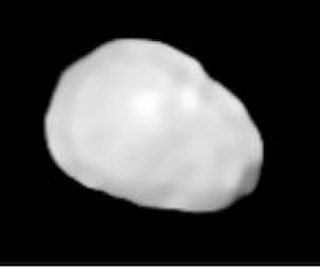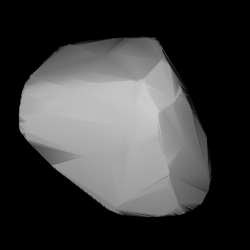5145 Pholus is an eccentric centaur in the outer Solar System, approximately 180 kilometers in diameter, that crosses the orbit of both Saturn and Neptune. It was discovered on 9 January 1992 by American astronomer David Rabinowitz (uncredited) of UA's Spacewatch survey at the Kitt Peak National Observatory in Arizona, United States. The very reddish object has an elongated shape and a rotation period of 9.98 hours. It was named after the centaur Pholus from Greek mythology.

28978 Ixion (, provisional designation 2001 KX76) is a large trans-Neptunian object and a possible dwarf planet. It is located in the Kuiper belt, a region of icy objects orbiting beyond Neptune in the outer Solar System. Ixion is classified as a plutino, a dynamical class of objects in a 2:3 orbital resonance with Neptune. It was discovered in May 2001 by astronomers of the Deep Ecliptic Survey at the Cerro Tololo Inter-American Observatory, and was announced in July 2001. The object is named after the Greek mythological figure Ixion, who was a king of the Lapiths.

Tholins are a wide variety of organic compounds formed by solar ultraviolet or cosmic ray irradiation of simple carbon-containing compounds such as carbon dioxide, methane or ethane, often in combination with nitrogen or water. Tholins are disordered polymer-like materials made of repeating chains of linked subunits and complex combinations of functional groups, typically nitriles and hydrocarbons, and their degraded forms such as amines and phenyls. Tholins do not form naturally on modern-day Earth, but they are found in great abundance on the surfaces of icy bodies in the outer Solar System, and as reddish aerosols in the atmospheres of outer Solar System planets and moons.

Eunomia is a very large asteroid in the middle asteroid belt. It is the largest of the stony (S-type) asteroids, with 3 Juno as a close second. It is quite a massive asteroid, in 6th to 8th place. It is the largest Eunomian asteroid, and is estimated to contain 1% of the mass of the asteroid belt.

Klymene is a large, dark Themistian asteroid that was discovered by J. C. Watson on September 13, 1868, and named after one of the many Clymenes in Greek mythology. It is orbiting the Sun with a period of 5.60 years and an eccentricity of 0.16. The orbital plane is inclined by 2.8° to the plane of the ecliptic. It is classified as a C-type asteroid, indicating it probably has a carbonaceous composition. The spectra indicates the presence of aqueous-altered minerals on the surface based upon a sharp feature at a wavelength of 3 μm, and, as of 2015, is the only member of the Themis family found to show this absorption.

Ophelia is a large, dark Themistian asteroid that was discovered by French astronomer Alphonse Borrelly on 13 January 1877, and named after Ophelia in Shakespeare's Hamlet.
The Themis family is a family of carbonaceous asteroids located in the outer portion of the asteroid belt, at a mean distance of 3.13 AU from the Sun. It is one of the largest families with over 4700 known members, and consists of a well-defined core of larger bodies surrounded by a region of smaller ones. The collisional Themis family is named after its parent body, the asteroid 24 Themis, discovered on 5 April 1853 by Italian astronomer Annibale de Gasparis.

Pompeja is a quite large main-belt asteroid. It was discovered by C. H. F. Peters on September 25, 1879, in Clinton, New York, and named after Pompeii, the Roman town destroyed in volcanic eruption in AD 79. This asteroid is orbiting the Sun at a distance of 2.74 AU with an eccentricity (ovalness) of 0.06 and a period of 4.53 yr. The orbital plane is tilted at an angle of 3.2° to the plane of the ecliptic.

Lucia is a large Themistian asteroid. It was discovered by Johann Palisa on 9 February 1882 in Vienna and named after Lucia, daughter of Austro-Hungarian explorer Graf Wilczek.

Justitia is a fairly sizeable main belt asteroid around 50 km in diameter
848 Inna is a carbonaceous Themistian asteroid from the outer regions of the asteroid belt. It was discovered on 5 September 1915, by astronomer Grigory Neujmin at the Simeiz Observatory on the Crimean peninsula. The C-type asteroid measures approximately 33 kilometers in diameter, while its rotation period remains unknown. It was named after Russian astronomer Inna Nikolaevna Leman-Balanovskaya (1881–1945).
981 Martina is a carbonaceous Themistian asteroid from the outer regions of the asteroid belt, approximately 31 kilometers in diameter. It was discovered on 23 September 1917, by Russian astronomer Sergey Belyavsky at the Simeiz Observatory on the Crimean peninsula. The C/B-type asteroid has a rotation period of 11.3 hours. It was named after French historian and revolutionary Henri Martin (1810–1883).
1764 Cogshall, provisional designation 1953 VM1, is a carbonaceous Themistian asteroid from the outer regions of the asteroid belt, approximately 26 kilometers in diameter. It was discovered on 7 November 1953 by astronomers of the Indiana Asteroid Program at Goethe Link Observatory in Indiana, United States. The asteroid was named after Wilbur Cogshall, professor of astronomy at Indiana University.

2708 Burns is a carbonaceous Themistian asteroid from the outer regions of the asteroid belt, approximately 19 kilometers in diameter. It was discovered on 24 November 1981, by American astronomer Edward Bowell at the Anderson Mesa Station near Flagstaff, Arizona, in the United States. It was named after American planetary scientist Joseph A. Burns. The likely elongated B-type asteroid has a rotation period of 5.3 hours.
2325 Chernykh, provisional designation 1979 SP, is a dark Themistian asteroid from the outer regions of the asteroid belt, approximately 23 kilometers in diameter. It was discovered on 25 September 1979, by Czech astronomer Antonín Mrkos at the Klet Observatory in the Czech Republic. The asteroid was named after Russian astronomer couple Lyudmila Chernykh and Nikolai Chernykh.
2882 Tedesco, provisional designation 1981 OG, is a Themistian asteroid from the outer regions of the asteroid belt, approximately 22 kilometers in diameter. It was discovered on 26 July 1981, by astronomer Edward Bowell at the Anderson Mesa Station near Flagstaff, Arizona. The likely elongated C-type asteroid has a rotation period of 19.8 hours. It was named for American astronomer Ed Tedesco.
1340 Yvette, provisional designation 1934 YA, is a carbonaceous Themistian asteroid from the outer regions of the asteroid belt, approximately 29 kilometers in diameter. It was discovered on 27 December 1934, by astronomer Louis Boyer at the Algiers Observatory, who named it after his niece, Yvette.
2039 Payne-Gaposchkin, provisional designation 1974 CA, is a carbonaceous Themistian asteroid from the outer regions of the asteroid belt, approximately 14 kilometers in diameter. The asteroid was discovered on 14 February 1974, by astronomers at the George R. Agassiz Station of the Harvard College Observatory in Massachusetts, United States. It was named for British–American astronomer Cecilia Payne-Gaposchkin.
(55638) 2002 VE95 (provisional designation 2002 VE95) is a trans-Neptunian object from the outermost region of the Solar System. It was discovered on 14 November 2002, by astronomers with the Near-Earth Asteroid Tracking program at the Palomar Observatory in California, United States. This resonant trans-Neptunian object is a member of the plutino population, locked in a 2:3 resonance with Neptune. The object is likely of primordial origin with a heterogeneous surface and a notably reddish color (RR) attributed to the presence of methanol and tholins. It has a poorly defined rotation period of 6.8 hours and measures approximately 250 kilometers (160 miles) in diameter, too small to be a dwarf planet candidate. As of 2021, it has not yet been named.

A planetary surface is where the solid or liquid material of certain types of astronomical objects contacts the atmosphere or outer space. Planetary surfaces are found on solid objects of planetary mass, including terrestrial planets, dwarf planets, natural satellites, planetesimals and many other small Solar System bodies (SSSBs). The study of planetary surfaces is a field of planetary geology known as surface geology, but also a focus on a number of fields including planetary cartography, topography, geomorphology, atmospheric sciences, and astronomy. Land is the term given to non-liquid planetary surfaces. The term landing is used to describe the collision of an object with a planetary surface and is usually at a velocity in which the object can remain intact and remain attached.











